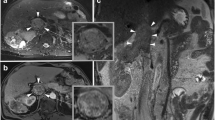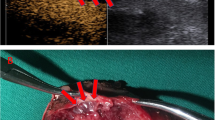Abstract
Objective
To identify adhesive renal venous tumor thrombus (RVTT) of renal cell carcinoma (RCC) by contrast-enhancement CT (CECT).
Materials and methods
Our retrospective study included 53 patients who underwent preoperative CECT and pathologically confirmed RCC combined with RVTT. They were divided into two groups based on the intra-operative findings of RVTT adhesion to the venous wall, with 26 cases in the adhesive RVTT group (ARVTT) and 27 cases in the non-adhesive group (NRVTT). The location, maximum diameter (MD) and CT values of tumors, the maximum length (ML) and width (MW) of RVTT, and length of inferior vena cava tumor thrombus were compared between the two groups. The presence of renal venous wall involvement, renal venous wall inflammation, and enlarged retroperitoneal lymph node was compared between the two groups. A receiver operating characteristic curve was used to analyze the diagnostic performance.
Results
The MD of RCC and the ML and MW of the RVTT were all larger in the ARVTT group than in the NRVTT group (p = 0.042, p < 0.001, and p = 0.002). The proportion of renal vein wall involvement and renal vein wall inflammation were higher in the ARVTT group than in NRVTT groups (both p < 0.001). The multivariable model including ML and vascular wall inflammation to predict ARVTT could achieve the best diagnostic performance with the area under the curve, sensitivity, specificity, and accuracy of 0.91, 88.5%, 96.3%, and 92.5%, respectively.
Conclusion
The multivariable model acquired by CECT images could be used to predict RVTT adhesion.
Clinical relevance statement
For RCC patients with tumor thrombus, contrast-enhanced CT could noninvasively predict the adhesion of tumor thrombus, thus predicting the difficulty of surgery and contributing to the selection of an appropriate treatment plan.
Key Points
• The length and width of the tumor thrombus could be used to predict its adhesion to the vessel wall.
• Adhesion of the tumor thrombus can be reflected by inflammation of the renal vein wall.
• The multivariable model from CECT can well predict whether the tumor thrombus adhered to the vein wall.




Similar content being viewed by others
Abbreviations
- ARVTT:
-
Adhesive renal venous tumor thrombus
- AUC:
-
Area under the curve
- CECT:
-
Contrast-enhancement computed tomography
- IVC:
-
Inferior vena cava
- L-VCT:
-
Length of the tumor thrombus in the inferior vena cava
- MD:
-
Maximum diameter
- ML:
-
Maximum length
- MW:
-
Maximum width
- NRVTT:
-
Non-adhesive renal venous tumor thrombus
- RCC:
-
Renal cell carcinoma
- ROC:
-
Receiver operating characteristic
- RVTT:
-
Renal venous tumor thrombus
- VCT:
-
Tumor thrombus in the inferior vena cava
References
Capitanio U, Bensalah K, Bex A et al (2019) Epidemiology of renal cell carcinoma. Eur Urol 75(1):74–84
Moch H, Cubilla AL, Humphrey PA, Reuter VE, Ulbright TM (2016) The 2016 WHO classification of tumours of the urinary system and male genital organs-part A: renal, penile, and testicular tumours. Eur Urol 70(1):93–105
Lardas M, Stewart F, Scrimgeour D et al (2016) Systematic review of surgical management of nonmetastatic renal cell carcinoma with vena caval thrombus. Eur Urol 70(2):265–280
Quencer KB, Friedman T, Sheth R, Oklu R (2017) Tumor thrombus: incidence, imaging, prognosis and treatment. Cardiovasc Diagn Ther 7(Suppl 3):S165–S177
Karaosmanoglu AD, Onur MR, Uysal A, Akata D, Ozmen MN, Karcaaltincaba M (2020) Tumor in the veins: an abdominal perspective with an emphasis on CT and MR imaging. Insights Imaging 11(1):52
González J, Gorin MA, Garcia-Roig M, Ciancio G (2014) Inferior vena cava resection and reconstruction: technical considerations in the surgical management of renal cell carcinoma with tumor thrombus. Urol Oncol 32(1):34.e19–26
Abaza R, Angell J (2013) Robotic partial nephrectomy for renal cell carcinomas with venous tumor thrombus. Urology 81(6):1362–1367
Shchukin D, Lisova G, Khareba G et al (2019) Nephron-sparing surgery in patients with renal cell carcinoma extending to the main renal vein: intrarenal and extrarenal thrombectomy. Georgian Med News 297:23–30
Marra G, Gontero P, Brattoli M et al (2018) Is imperative partial nephrectomy feasible for kidney cancer with venous thrombus involvement? Outcomes of 42 cases and matched pair analysis with a large radical nephrectomy cohort. Urol Oncol 36(7):339.e331-339.e338
Kunath F, Schmidt S, Krabbe LM et al (2017) Partial nephrectomy versus radical nephrectomy for clinical localised renal masses. Cochrane Database Syst Rev 5(5):Cd012045
Scosyrev E, Messing EM, Sylvester R, Campbell S, Van Poppel H (2014) Renal function after nephron-sparing surgery versus radical nephrectomy: results from EORTC randomized trial 30904. Eur Urol 65(2):372–377
Li M, Cheng L, Zhang H et al (2020) Laparoscopic and robotic-assisted partial nephrectomy: an overview of hot issues. Urol Int 104(9–10):669–677
Chang KD, Abdel Raheem A, Kim KH et al (2018) Functional and oncological outcomes of open, laparoscopic and robot-assisted partial nephrectomy: a multicentre comparative matched-pair analyses with a median of 5 years’ follow-up. BJU Int 122(4):618–626
Liu Z, Tang S, Tian X et al (2020) Laparoscopic conversion to open surgery in radical nephrectomy and tumor thrombectomy: causal analysis, clinical characteristics, and treatment strategies. BMC Surg 20(1):185
Tian X, Hong P, Liu Z et al (2020) En bloc retroperitoneal laparoscopic radical nephrectomy with inferior vena cava thrombectomy for renal cell carcinoma with level 0 to II venous tumor thrombus: a single-center experience. Cancer 126(Suppl 9):2073–2078
Psutka SP, Boorjian SA, Thompson RH et al (2015) Clinical and radiographic predictors of the need for inferior vena cava resection during nephrectomy for patients with renal cell carcinoma and caval tumour thrombus. BJU Int 116(3):388–396
Li QY, Li N, Huang QB et al (2019) Contrast-enhanced ultrasound in detecting wall invasion and differentiating bland from tumor thrombus during robot-assisted inferior vena cava thrombectomy for renal cell carcinoma. Cancer Imaging 19(1):79
Adams LC, Ralla B, Bender YY et al (2018) Renal cell carcinoma with venous extension: prediction of inferior vena cava wall invasion by MRI. Cancer Imaging 18(1):17
Wu K, Wu P, Yang K et al (2022) A comprehensive texture feature analysis framework of renal cell carcinoma: pathological, prognostic, and genomic evaluation based on CT images. Eur Radiol 32(4):2255–2265
Demirjian NL, Varghese BA, Cen SY et al (2022) CT-based radiomics stratification of tumor grade and TNM stage of clear cell renal cell carcinoma. Eur Radiol 32(4):2552–2563
Zheng Z, Chen Z, Xie Y, Zhong Q, Xie W (2021) Development and validation of a CT-based nomogram for preoperative prediction of clear cell renal cell carcinoma grades. Eur Radiol 31(8):6078–6086
Wang BS, Li YZ, Fang YY, Zhang SD, Ma LL (2020) Imaging predictors for assessment of inferior vena cava wall invasion in patients with renal cell carcinoma and inferior vena cava tumor thrombus: a retrospective study. Chin Med J (Engl) 133(17):2078–2083
Alayed A, Krishna S, Breau RH et al (2019) Diagnostic accuracy of MRI for detecting inferior vena cava wall invasion in renal cell carcinoma tumor thrombus using quantitative and subjective analysis. AJR Am J Roentgenol 212(3):562–569
Narváez J, Narváez JA, Nolla JM, Sirvent E, Reina D, Valverde J (2005) Giant cell arteritis and polymyalgia rheumatica: usefulness of vascular magnetic resonance imaging studies in the diagnosis of aortitis. Rheumatology (Oxford) 44(4):479–483
Blute ML, Leibovich BC, Lohse CM, Cheville JC, Zincke H (2004) The Mayo Clinic experience with surgical management, complications and outcome for patients with renal cell carcinoma and venous tumour thrombus. BJU Int 94(1):33–41
Kulkarni J, Jadhav Y, Valsangkar RS (2012) IVC thrombectomy in renal cell carcinoma-analysis of out come data of 100 patients and review of literature. Indian J Surg Oncol 3(2):107–113
Liu Z, Li L, Hong P et al (2020) A predictive model for tumor invasion of the inferior vena cava wall using multimodal imaging in patients with renal cell carcinoma and inferior vena cava tumor thrombus. Biomed Res Int 2020:9530618
Oikonomou EK, Marwan M, Desai MY et al (2018) Non-invasive detection of coronary inflammation using computed tomography and prediction of residual cardiovascular risk (the CRISP CT study): a post-hoc analysis of prospective outcome data. Lancet 392(10151):929–939
Channon K M, Newby D E, Nicol E D, Deanfield J (2022) Cardiovascular computed tomography imaging for coronary artery disease risk: plaque, flow and fat. Heart 108:1510–1515
Funding
This work was supported by the National High Level Hospital Clinical Research Funding (grant no.2022-PUMCH-A-033), the CAMS Innovation Fund for Medical Sciences (grant no.2022-I2M-C&T-B-019), the National High Level Hospital Clinical Research Funding (grant no.2022-PUMCH-B-069), the National High Level Hospital Clinical Research Funding (grant no.2022-PUMCH-A-035), the National Natural Science Foundation of China (grant no.81901742), the National Natural Science Foundation of China (grant no. 91859119), and the 2021 Key clinical Specialty Program of Beijing, Beijing Municipal Key Clinical.
Author information
Authors and Affiliations
Corresponding authors
Ethics declarations
Guarantor
The scientific guarantor of this publication is Hao Sun.
Conflict of interest
The authors of this manuscript declare no relationships with any companies, whose products or services may be related to the subject matter of the article.
Statistics and biometry
No complex statistical methods were necessary for this paper.
Informed consent
Written informed consent was waived by the Institutional Review Board.
Ethical approval
Institutional Review Board approval was obtained.
Study subjects or cohorts overlap
Study subjects in this research have not been previously reported.
Methodology
• retrospective
• diagnostic or prognostic study
• performed at one institution
Additional information
Publisher's note
Springer Nature remains neutral with regard to jurisdictional claims in published maps and institutional affiliations.
Rights and permissions
Springer Nature or its licensor (e.g. a society or other partner) holds exclusive rights to this article under a publishing agreement with the author(s) or other rightsholder(s); author self-archiving of the accepted manuscript version of this article is solely governed by the terms of such publishing agreement and applicable law.
About this article
Cite this article
Zhang, X., Zhang, J., Zhang, G. et al. The feasibility of contrast-enhanced CT to identify the adhesive renal venous tumor thrombus of renal cell carcinoma. Eur Radiol 33, 7429–7437 (2023). https://doi.org/10.1007/s00330-023-09776-w
Received:
Revised:
Accepted:
Published:
Issue Date:
DOI: https://doi.org/10.1007/s00330-023-09776-w




